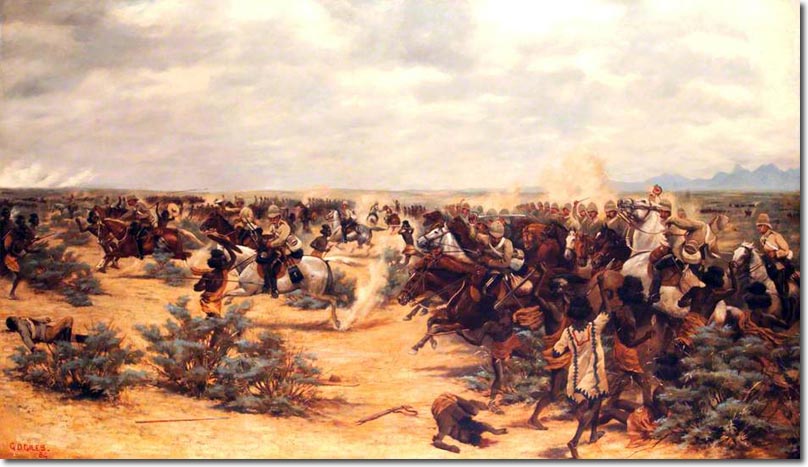|
|


|
|
On 29th April 1883 the Mahdi's army annihilated an Egyptian force, commanded by a retired Bombay Army officer, Colonel Hicks, at Kashgate. The remaining Egyptian garrisons, scattered across the Sudan, lay at the mercy of the Mahdi and his tribesmen.
In January 1884 a British officer, Baker Pasha, took an Egyptian force to Suakin on the coast of the Persian Gulf to provide cover for a withdrawal of the Egyptian garrisons in the East of the Sudan. The force was annihilated by the Mahdists at El Teb a few miles inland from a port called Trinkitat. The Mahdists moved on to besiege the other garrison towns in the area held by the Egyptians. In January 1884 at the urging of the British Government, the Khedive appointed General Charles Gordon to oversee the evacuation of the Egyptian forces from the Sudan. General Gordon had acted as governor of the Sudan in the 1870s with considerable effect. Gordon traveled from London to Khartoum, the capital of the Sudan, arriving on 18th February 1884. In the meanwhile a British army, commanded by Major General Graham, was dispatched from Egypt by ship down the Persian Gulf to land at Suakin and relieve the Egyptian garrison at Tokar, 50 miles to the South of Suakin. General Graham's force arrived at Suakin from 20th February 1884, the first regiment being the 10th Hussars. Other Royal Navy ships arrived with the remaining regiments. Once assembled, the force moved down the coast by ship to the lagoon of Trinkitat for the march to the relief of Tokar. On 22nd February 1884 General Graham received information from a group of Egyptian soldiers that the governor of Tokar had surrendered to the Mahdi's forces, his troops joining the rebels to avoid being massacred. The British force moved inland between two patches of salt marsh to occupy a position called Fort Baker, the scene of Baker Pasha's disaster the previous month: Colonel Baker was accompanying the British force. On 29th February 1884 the infantry brigade formed a square and began the advance to the hamlet of El Teb, some 2 � miles inland along the track to Tokar, where Osman Digna's Mahdists lay in position. The front of the square was formed by the Gordon Highlanders and the rear by the Black Watch, both in company columns of fours at company intervals. The right flank was formed by the 2nd Royal Irish Fusiliers and 3rd KRRC, the left flank by 1st York and Lancaster and RMLI, all in open column of companies. The angles of the square were filled by guns manned by Royal Artillery and Royal Navy personnel. Colonel Buller commanded the infantry brigade. The only baggage animals taken with the force carried spare ammunition. The cavalry, 10th and 19th Hussars and Mounted Infantry commanded by Colonel Stewart, followed the square at a distance. At 11.20am the Mahdists opened rifle and artillery fire, using the small arms and Krupp guns captured from the Egyptian forces they had annihilated in the course of the revolt. The British square halted and the infantry were ordered to lie down while the guns and machine guns fired on the Mahdists. The effect of this bombardment was to silence the Krupps. The square stood up and continued its advance under rifle fire. The British began to take casualties. When the square was within two hundred yards or so of the earthworks, the Mahdist tribesmen abandoned their firearms and charged the square with spears and swords. Large numbers of the tribesmen were shot down by the infantry with rifle fire and by the Gardiner and Gatling guns of the Naval Brigade. None broke into the square. Following this assault, the tribesmen fell back and the square reformed and resumed its advance. At this point Colonel Stewart's Cavalry Brigade advanced past the right flank of the square and charged the massed Mahdist tribesmen, leading to a confused struggle with the tribesmen in the broken country covered by thorn bushes. The cavalry suffered heavy casualties in the scrimmage. As the British infantry reached the earthworks, the battalions moved out of square formation and, forming line, stormed the tribesmen's positions at the point of the bayonet. At around 1pm General Graham's troops took the hamlet of El Teb and the Mahdists began to stream away into the surrounding country. |
Timelines | 19th Century Timeline
Armed Forces | Art and Culture | Articles | Biographies | Colonies | Discussion | Glossary | Home | Library | Links | Map Room | Sources and Media | Science and Technology | Search | Student Zone | Timelines | TV & Film | Wargames